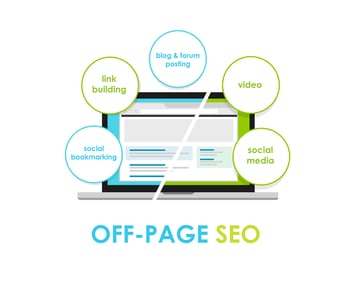How to Optimize Your Website to Get Your Business Found Online
Part 2 of an 8 part series.
The Eight Essential Steps To Successful Internet Marketing
Step 2: Optimize Your Website To Get Found
When you see a newspaper at a newsstand or in a box, the first part you see is the top half of the front page. That is the part of the paper considered "above the fold." It is where the big headlines sit and where every newspaper reporter in the world wants their by-line.
What does that have to do with Internet marketing? You want your company to come in "above the fold" when it comes to search engine ranking. You want that top spot so visitors will be more likely to come to your site instead of your competition's.
What Does It Mean to be "Above the Fold"?
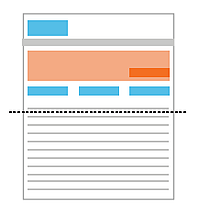 How do you get your company in that coveted position? The answer is with search engine optimization, or SEO.
How do you get your company in that coveted position? The answer is with search engine optimization, or SEO.
In most cases, to come in "above the fold" means having your company appear in the first page of search engine results. The top three spots are the most coveted. But, for a big industry with a lot of competition, you want to appear in the first couple of pages. You have to optimize your website and your social media profiles to make that happen. Both work together to propel your company to those lofty ranks.
A note on content: While Google says you need to design your website for visitors, not search engines, you need to keep search engines in mind when you optimize. Balancing quality content with search engine optimization is the best route to take.
What Do You Need to Know About SEO?
You will find two categories of SEO: on-page and off-page.
-
On-Page SEO refers to how your website content plays to search engines. This counts for 25 percent of how search engines rank your site or a particular web page.
-
Off-Page SEO refers to what other websites say about your site. If other sites reference your site using inbound links, this lends credence in the eyes of search engine bots. This counts for 75 percent of how search engines rank your site or page.
Even though on-page SEO counts for only 25 percent, this needs to be your area of first concern. You can make changes to it immediately. Off-page SEO is something that takes time to build and refine.
Nine Essential Components of On-Page Website Optimization
What do you need to do?
Component #1 - Page Title
When you look at the top of your browser on a web page, the text you see is the title of the page. In the HTML , it is what appears between the <title> tags.
Here is how you optimize the page title:
-
The title needs to include keywords
-
Make your title 70 characters or less since Google search results only show that much. That count includes spaces and punctuation.
-
Put keywords close to the start of the title for the most impact
-
The title needs to appeal to site visitors and give relevant information on the page's contents
-
Include your company name at the end of the page title
-
Use different titles for each page and use different keywords on each page.
Component #2 - Meta Description and Meta Data
Meta data are HTML tags that provide a holder for page information. This can include the author, the language, and the last modified date, among others. The meta description tag is one of these tags.
The meta description does not display on the web page itself. However, Google will display it in the search engine results as a description for the web page. While it does not influence search engine rankings, the description does provide the searcher with pertinent information. Using keywords and providing some detail in the description can get the searcher's attention. Ideally, the description will be 150 characters or less since that is what Google will display.
If Google does not find a meta description in the HTML tags, the default is to show the first few words on the website.
Component #3 - Headings
If you look at the HTML in any website page, you will see tags like <h1>, <h2>, or <h3>. These are heading tags. They make certain pieces of information more prominent than others on the site.
Search engines give more weight to any words or phrases inside these header tags. Those with the <h1> tag will get more weight than those with the <h2> tag. The <h2> tags will have more weight than the <h3> tags.
How to use your headers for search engine optimization:
-
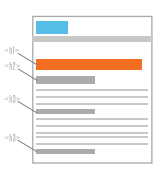 Use only one <h1> tag in the page.
Use only one <h1> tag in the page. -
Do not over use any header tags. Too many will dilute the weight placed on your headers.
-
While <h4>, <h5>, and <h6> tags exist, they carry no value with search engines.
-
Use keywords in headers for added weight.
-
Throw in a few <h2> and <h3> tags to break up paragraphs in order to make reading easier.
Headers help with human readability, but you can also use them for SEO.
Component #4 - Cascading Style Sheets (CSS)
Most modern websites use cascading style sheets (CSS) to handle the format and visual aspects. Older websites only used HTML markup for these functions.
Using CSS can improve your search engine ranking. Search engine bots read the HTML text in your web pages. If you have a bunch of formatting information in your web page, this dilutes the weight of your content in the eyes of the search engine bots. If your website currently only uses HTML markup for formatting, transition to CSS for more impact.
Component #5 - Images
Images are part of the visual package you are presenting to your visitors. They enhance the user's experience. For SEO purposes, you need to keep a few things in mind:
-
Use a small number of images. Putting too many images on a page can slow down the load time. That will be a negative for the user's experience and it also counts against your search engine ranking.
-
Keep the size of your images to the smaller side. Let's say you have only one image on your site. That is great for SEO, right? Maybe. If the image file is too large, you will get a slow load time and have the search engines count it against you.
-
Always associate text with images. Each image should have ALT text added to it because search engines do not know what a picture contains. You can give a keyword rich description in the ALT text to gain SEO traction.
-
Make your image file name relevant and keyword rich. Many people visit a website first because an image draws their attention. Separate keywords with a dash in the file name.
Component #6 - Domain Information
How long have you extended your domain name commitment for? Most people renew their domain name every year or two without thinking about the impact it has on their search engine rankings. The search engines actually love sites with a long registration time. It indicates that the site is less likely to be spam. You can stretch out the registration time for many years and see a positive impact to your SEO results.
Component #7 - MOZ Rank
The MOZ rank comes from an algorithm that ranks a web page's authority from zero to ten, with ten being the highest. This algorithm looks at both on-page and off-page SEO. When you make changes to your on-page SEO, it can bring your MOZ rank up. You can find a few places on the web where they will show your MOZ rank when you type in your URL.
Component #8 - Google Crawl Date
You want Google to crawl your site as often as possible. When their search engine bots crawl your site, they update the indexing information related to it, including your keywords and SEO efforts. You can get Google to look at your site more often by doing regular updates with fresh content.
Component #9 - URL Structure
The URL of any web page is the web address people and search engines use to get to that particular one. Your URL structure can actually work in your favor when it comes to SEO. Adding keywords to your URL and making it humanly readable makes it search engine friendly.
Here are some more tips for making your URL structure SEO friendly:
-
Apply a 301 Redirect when appropriate. A 301 redirect allows you to redirect an old URL to a new one. If you change the URL of any page on your site, make sure to put a 301 redirect in for the new page. Also, make sure you put a redirect in place between the name of your website with and without the www in front. For example, put a 301 redirect for yoursite.com to www.yoursite.com. If you do not do this, search engines may count the two names as separate sites. That will cut your SEO impact in half.
-
Keep URL nests to one or two levels only. Here is an example of a deeply nested URL: http://yoursite.com/about/management/president/contact/phone. This URL has five sublevels. This type of nesting gets less SEO credit. A better site design will help improve this problem.
-
Include keywords in your URLs. If you have not purchased a domain name yet, find one that has a keyword included. If you already have a domain name, don't worry. You can get keywords embedded in the titles of your internal pages.
-
Separate keywords with dashes. Replace any spaces in your URLs with dashes (-). For example, http://yoursite.com/inbound-marketing/ is a good URL since it captures "inbound marketing" as a keyword.
-
Create static URLs/Avoid dynamic URLs. A static URL is always the same. The example http://yoursite.com/inbound-marketing/ is an example of a static one. A dynamic URL can change in different circumstances. An example is http://www.yoursite.com/forums/thread.php?threadid=12345&sort=date. Search engines love static URLs. Because dynamic ones can change, they will have less weight with the search engines. Most content management systems offer a way to set-up static page names.
Balance is Critical
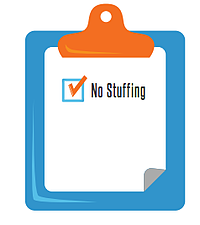 Avoid keyword stuffing. A major mistake some web designers make is trying to maximize the use of keywords by stuffing as many of them as possible on a single web page. You have seen pages like this. Let's say the keyword was "dog food." The text of the web site reads something like this: "Dog food is great. Dog food is nutritious. My dog loves dog food. Your dog will love dog food."
Avoid keyword stuffing. A major mistake some web designers make is trying to maximize the use of keywords by stuffing as many of them as possible on a single web page. You have seen pages like this. Let's say the keyword was "dog food." The text of the web site reads something like this: "Dog food is great. Dog food is nutritious. My dog loves dog food. Your dog will love dog food."
They think that using as many keywords in the shortest amount text possible will enhance their search engine rankings. In fact, the exact opposite happens. Search engines bots are getting smarter and smarter. When a page comes back with too many keywords, the search engines will rank it lower.
Improving Off-Page SEO with Inbound Links
As pointed out before, off-page SEO makes up 75 percent of your search engine ranking. It's simple. Search engines look at what other websites "say" about you. If other websites have plenty to "say" about you, you will get a higher authority ranking and a higher search engine ranking.
How does the search engine know what other websites are "saying"? Inbound links.
Inbound links are a major indicator of a website's authority. An inbound link happens when another website links to one of your website pages. The easiest way to get those links is to create high-quality, easy to share content, then start sharing it through social media. When you start spreading the word to your followers, they will start linking to it. Also, share it in industry forums and on other places where you talk about industry related topics.
How does the weight of inbound links differ?
-
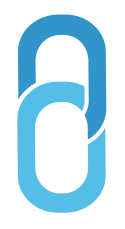 The higher number of inbound links you have, the higher your authority level. Links from one site count less than links from 10 sites.
The higher number of inbound links you have, the higher your authority level. Links from one site count less than links from 10 sites. -
The authority rank of the linking website carries weight. For example, a link from a major newspaper site would rank higher than one from your local chat group.
-
The linking page's title counts towards the weight. If the title is generic like "Home," it will count less than a title that is similar to your web page content.
-
The anchor text used on the link also counts. Much like the title, if the anchor text is relevant to your page content, that link counts more.
That is how you increase your "link love."
Read Step 1: Create A Keyword Strategy
Don't want to wait for the rest of the steps? Download The 8 Essential Steps to Successful Internet Marketing eBook now.



